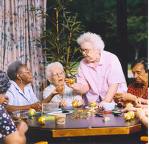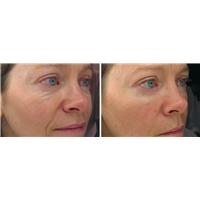London: A new report released today reveals a significant shift in the way 50 to 65 year-olds are viewing retirement, showing how role models such as Harrison Ford and Madonna are giving rise to a generation of grandad-olescents.
The study, by leading pensions company AEGON, shows retirement in the noughties is becoming a second adolescence, and more likely to include a world trip or a new career, than a carriage clock and a pair of slippers. A clear indication this generation of baby boomers has more in common with their teenage grandchildren than their own parents.
Over 2,000 people between the ages of 50 and 65 were surveyed to gauge their attitudes towards retirement and to see what sort of financial provision they have in place.
The survey reveals that 56% expect to carry on working in some capacity after they reach retirement age and, for most, not because they have to. More than one in ten (11%) said love of the job made them want to stay in the work force while 14% argued that they were simply too young to retire. Interestingly, 12% said they would like to try out a completely different career in their retirement.
For those who dont plan to keep working, the lure of far flung destinations beckons. The report shows that more than a fifth (21%) plans to use their grandad-olescence for a holiday of a lifetime. Taking inspiration from teenagers heading off on GAP years, 14% of all those surveyed said they wanted to take a long-haul touring trip, 15% fancied travelling around Europe and 7% were after an adventure or action holiday.
Improved health and increasing life expectancy mean that many reaching retirement age do not regard themselves as old, and therefore seek more active interests in their golden years. Nearly a third of respondents (30%) saw retirement as the chance to do all the things theyve wanted to do but never had the time, and a quarter (26%) plan to use their free time to take up new hobbies and leisure activities.
If their role models are anything to go by, these hobbies are going to be anything but sedate. According to the report, young-at-heart celebrities like Sir David Attenborough, Dame Judi Dench and the Queen of Pop, Madonna, are setting the standard for those at retirement age.
So while attitudes to retirement have clearly shifted with a greater emphasis on work, travel and leisure, are people approaching retirement better financially prepared?
Thanks to exceptional social and economic factors, baby boomers should be in a better position financially to enjoy retirement than any previous generation. In fact, 42% think they will be better off than their parents in retirement and 32% think they will be better off than their children. Understandably, securing a guaranteed income during retirement is at the top of the wish list, with 87% of respondents saying this is most important to them.
With all these adventurous ambitions, a secure income is going to be essential. Yet the report highlights a significant knowledge gap when it comes to planning, as 42% of respondents have no clear idea about how much income they will have in retirement. Of the remainder, 44% expected to get an income less than £15,000 a year and only 14% thought their pension savings would produce over £15,000 a year.
Interestingly, 33% are relying on their pension alone, with no other savings or investments and more than half (51%) admit that they could have been better prepared had they thought about planning sooner.
Rachel Vahey, Head of Pensions Development at AEGON, comments: Retirement isnt the abrupt cliff edge it once was and, for many of todays baby boomers, retirement age marks a new and exciting chapter of their lives. But if you want to make adventurous life choices and have a more flexible approach to retirement, it requires careful planning. Younger generations should take note and make sure that they have enough income to enjoy their second adolescence.
Other research findings at a glance:
· 67% of people surveyed have some savings and investments, other than in a pension. 33% say they have no savings or investments outside their pensions.
· 47% of respondents dont expect to have any outstanding mortgage or other debts at retirement. However 13% expect to have debts greater than £20,000 at retirement.
· 86% say they would at least “get by” financially if they were to stop working at retirement age. However, 14% say they would struggle to cope financially
· 21% of respondents say they will use the tax-free cash sum from their pensions to pay for the holiday of a lifetime. 15% say they will use the money to pay off their mortgage and 14% will use it to support their children financially.
· Over a quarter (27%) of respondents state their biggest fear in retirement is not being able to take care of themselves, while 22% fear running out of money in retirement
· 79% of respondents expect to need access to additional money in retirement for things such as long-term care, health emergencies, their children and home improvements
About AEGON
· AEGON commissioned Onepoll in to carry out research in May 2008, surveying 2,140 people aged between 50 and 65 who have not yet retired.
· In 2010 the number of pensioners will have exceeded the number of children in the population for the first time. Currently there are 11.3m people over state retirement age, projected to reach 12.2m by 2010 (Source: Office of National Statistics, October 2007).
· The proportion of people over the state pension age has grown from 16% in 1971 to 19% in 2004. By 2031, this figure is projected to have increased to 23%. (Source: Office for National Statistics).
· One hundred years after their introduction, British pensions are now the lowest in the European Union. A recent survey found that the basic state pension of £90.70 a week is equivalent to 17 per cent of the average earnings, compared with the EU average of 57 per cent.
· Current legislation dictates that between 2024 and 2026 the retirement age will rise to 68 for both men and women.
· AEGON UK is one of the top 5 life and pension providers in the UK, employing around 4,500 staff and with assets under administration of £53.2 billion. AEGON UK is part of the AEGON group, which is one of the worlds largest insurers and has assets under management of £245 billion.










